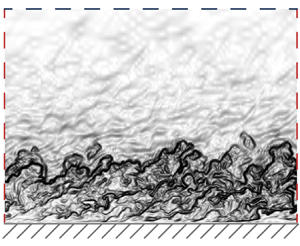Published online by Cambridge University Press: 13 September 2024

The scaling relations mapping the turbulence statistics in compressible turbulent boundary layers (TBLs) onto their incompressible counterparts are of fundamental significance for turbulence modelling, such as the Morkovin scaling for velocity fields, while for pressure fluctuation fields, a corresponding scaling relation is currently absent. In this work, the underlying scaling relations of pressure fluctuations about Mach number ( $M$) contained in their generation mechanisms are explored by analysing a series of direct numerical simulation data of compressible TBLs over a wide Mach number range
$M$) contained in their generation mechanisms are explored by analysing a series of direct numerical simulation data of compressible TBLs over a wide Mach number range  $(0.5\leq M \leq 8.0)$. Based on the governing equation of pressure fluctuations, they are decomposed into components according to the properties of source terms. It is notable that the intensity of the compressible component, predominantly originating from the acoustic mode, obeys a monotonic distribution about the Mach number and wall distance; further, the intensity of the rest of the pressure components, which are mainly generated by the vorticity mode, demonstrates a uniform distribution consistent with its incompressible counterpart. Moreover, the coupling between the two components is negligibly weak. Based on the scaling relations, semiempirical models for the fluctuation intensity of both pressure and its components are constructed. Hence, a mapping relation is obtained that the profiles of pressure fluctuation intensities in compressible TBLs can be mapped onto their incompressible counterparts by removing the contribution from the acoustic mode, which can be provided by the model. The intrinsic scaling relation can provide some basic insight for pressure fluctuation modelling.
$(0.5\leq M \leq 8.0)$. Based on the governing equation of pressure fluctuations, they are decomposed into components according to the properties of source terms. It is notable that the intensity of the compressible component, predominantly originating from the acoustic mode, obeys a monotonic distribution about the Mach number and wall distance; further, the intensity of the rest of the pressure components, which are mainly generated by the vorticity mode, demonstrates a uniform distribution consistent with its incompressible counterpart. Moreover, the coupling between the two components is negligibly weak. Based on the scaling relations, semiempirical models for the fluctuation intensity of both pressure and its components are constructed. Hence, a mapping relation is obtained that the profiles of pressure fluctuation intensities in compressible TBLs can be mapped onto their incompressible counterparts by removing the contribution from the acoustic mode, which can be provided by the model. The intrinsic scaling relation can provide some basic insight for pressure fluctuation modelling.